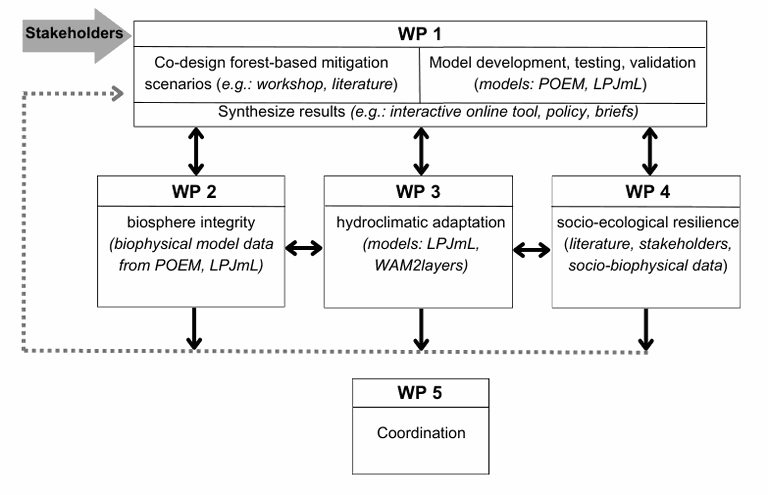ReForMit - Project overview
Project info
Climate mitigation in forest systems is critical for limiting global warming and has important implications for biosphere functions such as freshwater and biodiversity. However, there are major knowledge gaps with regard to the future resilience of forest-based interventions - i.e., their capacity to remain functional in delivering desirable water-climate-biodiversity functions despite natural and anthropogenic perturbations.
ReForMit (understanding and securing the Resilience of Forest-based climate change Mitigation) aims to close these gaps, by generating knowledge on how to safeguard the biophysical and social-ecological resilience of forest-based climate change mitigation measures under shifting hydroclimatic conditions including ecological droughts.
Project approach
In ReForMit, we will
(1) design forest-based mitigation scenarios in close collaboration with stakeholders,
(2) quantify the resilience and sustainability of the biosphere integrity of forest-based climate mitigation measures,
(3) analyze the local and remote effects of hydroclimatic adaptation, and
(4) holistically assess the social-ecological resilience of forest-based climate change mitigation measures.
Both modeling and empirical analyses will be applied to comprehensively account for water-climate-forest dynamics, including the coupling of a state-of-the-art dynamic vegetation model with an Earth system model and an atmospheric moisture tracking tool. The project will help enhance both the biophysical and social-ecological resilience of water-climate-biodiversity functions from forest-based mitigation measures.
Work packages
ReForMit is organized into five work packages (WPs) to support a more holistic consideration of biophysical and social-ecological resilience implications of forest measures under a shifting hydroclimate.
Across the five work packages (see below), we use a combination of Earth system model (POEM), global dynamic vegetation model (LPJmL) with enhanced representation of ecological adaptation, empirical data analyses, atmospheric moisture tracking tool (WAM2layers), and stakeholder engagement in case studies to co-develop scenarios and pilot social-ecological resilience assessment in the context of forest measures.

- WP1 co-develops forest-based mitigation scenarios with stakeholders iteratively and runs these scenarios using a combination of vegetation and Earth system model
- WP2 analyzes the interactions of these scenarios with biosphere integrity
- WP3 analyzes the role of hydroclimatic adaptation based on remote sensing data
- WP4 applies social-ecological resilience principles to case studies and integrates findings with decision-making.
Because the integration of ecohydrological and atmospheric feedbacks is at the cutting edge of current modeling capabilities, we will also allocate some resources for the testing and validation of the coupling between LPJmL and POEM.
Background
Forest-based climate change mitigation measures are launched worldwide in both the public and private sectors. However, the impacts are complex. Depending on location, type of measure, and implementation, forest measures can both enhance and degrade water-climate-biodiversity functions. For example, afforestation can reduce water yield in streams, leading to water scarcity, but also reduce erosion and generate rainfall. Moreover, ongoing climate change is already threatening the resilience of current forest systems, i.e., their ability to prepare for threats, absorb adverse impacts, and adapt to and recover from disruptive events. Major knowledge gaps remain with regard to what can be done to enhance the capacity of forest measures to remain functional under future changes in hydroclimate and increasing frequency, severity, and duration of ecological droughts. Previous research shows that forests can adapt to a shifting hydroclimate, e.g., by changing water-use efficiency, or rooting depth. For example, choosing species adapted to (future) climate conditions in reforestation can be one way to increase the resilience of forest measures. Studies also show vast differences in carbon uptake and resilience between managed forests and plantations compared to natural regrowth.
Furthermore, the choice of forest measure will impact the water-climate-biodiversity functions locally, but also remotely via atmospheric feedbacks such as through changes in albedo, atmospheric moisture transport, carbon sequestration, and fires. Mitigation measures are also intertwined within the social-ecological systems, and dependent on the social capacity to secure their functioning in the face of perturbations.
We are funded by
![]()

